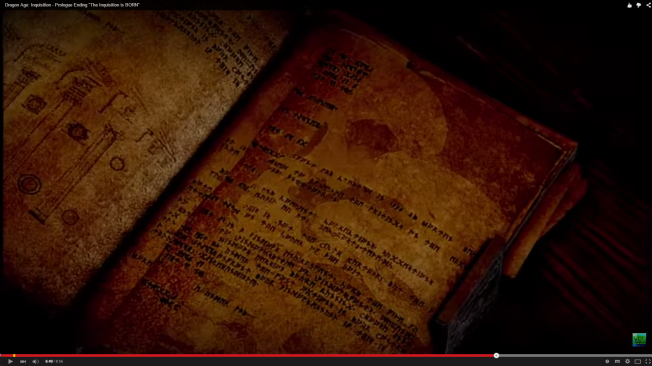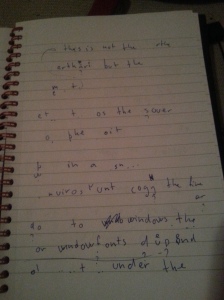In the early hours of Dragon Age: Inquisition, Cassandra brandishes a big, heavy book, which heralds the rebirth of the Inquisition (apologies to the non-gamers: quick recaps of events in games never make much sense if you haven’t played them). For a split second, you see a page in this book, and it’s full of runes!
I decided to do an exquisitely* nerdy thing: I wanted to find out what it said. Being better at runology than technology, I was proud that I at least managed to get a screen cap from the video:
Some things are clear even before starting to transliterate the text. The runes are from the Anglo-Saxon futhorc; some runes, like the a, w and g, are unique to this system. There are also a couple of hints that this is a transliteration from a modern language rather than an original text or a translation, the main tell being the use of doubled runes. You can see a couple of X-shaped runes next to each other towards the end of the third full row. Those are two g runes. In runic writing, there is no representation of vowel or consonant length, and next to no norm that tells the writer to write something he or she doesn’t hear – no silent h here. What this means is that doubled runes only occur in premodern runic writing when they’re in two different words, and not even always then. The word in Cassandra’s book containing two g‘s in fact transliterates as suggestions. Another good sign that you’re dealing with modern language is the absence of certain runes, namely the ones that don’t directly correspond to a letter in the Latin alphabet – ng or æ, for example.
So, behold the magic of transliteration from low resolution images of things never meant to be transliterated!
In the end, I got enough coherent text out of this to have something to Google. The words windows and font recurred, and I got the phrase the windows version youre running (which includes yet another pair of doubled runes, and a missed opportunity for using the ng rune). That search yielded nothing, but another one (about font options in the control panel) lead me to this, the readme file for the font.
This truetype-font was created in 1995 by Morten Bek.
It is supposed to resemble the writings on the maps from The Hobbit, by J.R.R.Tolkien.
If you have any comments, corrections, suggestions or questions, e-mail me at: bek@post3.tele.dk
Note that this is _not_ the Cirth (Certhar) but the letters used on the cover of The Hobbit.
To install in a windows environment, copy the file futhark.ttf to \windows\system or \windows\fonts, depending on the Windows version you’re running. Choose Install New Font under the Font options in your Control Panel (or confront your windows-manual if this is totally incromprehendible).
Please keep this file with the font, whenever you copy it and spread it to your friends.
More fonts are under way….
Morten
Upon double checking I could see that it is in fact the text found in Cassandra’s book. It appears that the game developers used a free online font from 1995 for their half second of runes, and did as the author asks: “Please keep this file with the font, whenever you copy it and spread it to your friends.” I did try to email the address given, but it bounced, as twenty year old email addresses will.
There really is no reason for BioWare to put anything more interesting in there when it comes to the contents of the text. It’s a split second view, and only people with strange ideas of fun will ever try to read it. Instead, it’s the form that matters here. The runes on the worn vellum are a shorthand for something ancient; a tradition that goes back so far that you, as the player and as the role you’re playing, don’t understand all of it. This scene ends the prologue to a very long game, and the use of runes helps to quickly place you in something larger and older than you. Of course, there are also practical considerations. By using a writing system few people can read immediately, the developers don’t need to come up with clever text in the book. And by using the Anglo-Saxon futhorc, they don’t need to come up with a writing system of their own. So that’s how they ended up with a Danish designer’s version of Tolkien’s version of Anglo-Saxon runes.
* An inquisition seeks within, something exquisite is sought out. Etymology!



Hey, thank you for doing the work, tracking the text source down and then presenting it in context here (with even some thoughtful analysis??) so I didn’t have to add a few more millimetres to the required thickness of my glasses by squinting at those tiny blurry runes for uncertain reward. This blog is lovely and I’m very glad I’m not the only person who saw that book closing and thought ‘no, wait!’
Have a good day!
LikeLike